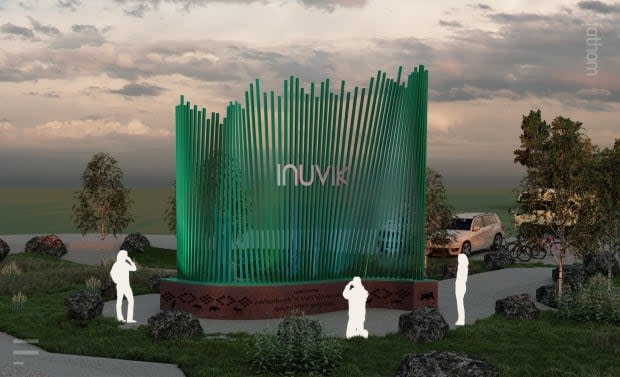Love it or hate it, this is Inuvik's new town sign
Designing a new town sign is not for the faint of heart.
It's a project that brings together local politics, regional identity, and public art — three things you're unlikely to ever find universal agreement on.
But that's the task the town of Inuvik faced, which is replacing a hand-painted mural that has welcomed visitors to the "end of the Dempster" for decades.
The winning bid for the project landed with a firm based in Dartmouth, Nova Scotia, Fathom Studio, that produces everything from brochures to master plans for mid-sized communities.
"They came in with something that was on scope and on budget, and they were the best firm to be selected," said Jackie Challis, the director of tourism & economic development for the town of Inuvik.
But that decision, and the designs that resulted, have ruffled feathers in town even before the sign is up.
"I just don't see anything positive here," said Ron English, a carver, painter, and sign maker born and raised in the community. "Again, we're stuck with something that was thought up down South."
Inspired by the landscape
The final design, which was chosen from three options presented by Fathom Studios, is dubbed the "Delta Borealis." The firm describes it on their Instagram as "a melding of local culture and environment rendered in anodized aluminum and CorTen steel."
Challis says the design was the result of "a pretty in-depth consultation process," that included an online survey, an open house, and multiple meetings with councillors and stakeholders.
Unusually for the firm, one of the designers, a landscape architect named Nicholas Robins, actually travelled the more than 23 in-flight hours to Inuvik, where he met with elders, councillors, and town administrators.
Robins said he wanted to "get a real sense of what the local landscape looked and felt like — what the tree species were, what the types of rock available [were]."
On a tour with the head of public works, he visited quarries and learned about dolomite, a local stone type that is "one of the oldest stones on the planet," he said.
"It has a really dark grey appearance, and really hard and almost luminous," he said. This is the stuff of landscape architects' dreams.
The design, Challis pointed out, incorporates elements beyond the landscape. Consultations emphasized the importance of representing all three local languages — Inuvialuktun, Gwich'in, and English — and the base is adorned with the delta braid, an important local pattern found on parkas and other crafted work.

'They just seem to bypass us': local artist
But for his part, English is unimpressed.
"The northern lights theme is hard to even grasp from what I see there," he said. "To me it looks very minimalist and barren and not representative of Inuvik."
English wishes the design contained more representation of Inuvik's human character — what Challis called the "braiding together" of three distinct cultures, Gwich'in, Inuvialuit, and settler. He also said it should be more immune to vandalism, an issue for monuments across the town.
But beyond the design, English is angry about how it came about. He said the town's process makes it impossible for small operators and local artists to bid on an important project like this one.
Aside from his experience as a sign maker, English recently completed a degree from the prestigious Emily Carr University of Art and Design in Victoria. He said it showed how flawed the consultation process was that he wasn't aware of the designs until they were unveiled.
"To come back and hear that they made a sign that's going to represent Inuvik without any consultation with artists like me, it again reaffirms what I've always believed," he said. "It doesn't matter what we do as locals around here, they just seem to bypass us."

Less public art, more 'functional infrastructure'
Challis said, ultimately, "there's a protocol in place."
"Obviously, if there was a local or northern firm that submitted a bid that met the price and scope, they would probably have preference. But there wasn't one," she said.
John deWolf, Fathom Studio's president, said at the end of the day, these kinds of projects are "less public art and more … functional infrastructure," limited by safety requirements.
"That said, that doesn't mean they have to be civic-looking," he said. "We can … make them look sculptural … or evocative of a culture."
But for English, the end result will always fall short.
Minimalist isolation, he said, "is their idea of [our] hopes and dreams.
"Compared to what the reality is here in Inuvik, it's a bit unsettling."


